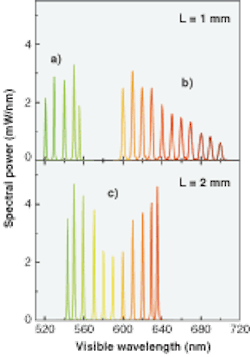Fiber Lasers: Fiber source tunes continuously in the visible

Many biological imaging and industrial testing applications depend on laser radiation in the visible, and could benefit greatly from a reliable source of tunable, visible radiation. Unfortunately, schemes that provide this tunable spectrum, such as downconversion of ultraviolet sources through optical parametric oscillators (OPO) and upconversion of the infrared output from OPOs through intracavity or extracavity sum-frequency mixing (SFM) and second-harmonic generation (SHG), are expensive and complicated. Researchers in the Department of Physics and Center for Applied Photonics at the University of Konstanz (Konstanz, Germany) have taken a different approach and demonstrated a compact device that combines a near-IR fiber-laser source with a single-pass frequency doubler to provide continuously tunable laser pulses from green to red with milliwatt average power levels.1
The setup consists of a diode-pumped modelocked erbium-fiber amplifier delivering 60 fs, 300 mW pulses at 1550 nm, that in turn pumps a 3.7 µm core diameter, polarization-maintaining, highly nonlinear fiber with a zero-dispersion wavelength near 1520 nm. The output from the nonlinear fiber is two mutually coherent maxima that differ by a factor of two in frequency, and are tunable by varying the amount of chirp in the pump pulses from the erbium fiber. The shorter-wavelength component of this output has an average power of more than 30 mW, pulses as short as 13 fs, and is tunable from 1050 to 1400 nm. By frequency doubling this tunable IR emission, tunable radiation from 520 to 700 nm in the visible can be extracted.
To perform frequency doubling and tuning, the researchers used continuously variable grating-period magnesium oxide-doped lithium niobate (MgO:LiNbO3) crystals of different lengths to cover the entire pump bandwidth. The nonlinear fiber output was focused onto the antireflection-coated crystals by an aspheric lens after passing through a half-wave plate for polarization control. The output beam was collimated by a second lens and transmitted through a short-pass filter. For a 2 mm long crystal, average visible power for the 630 nm radiation output was 9.5 mW. And for a 1 mm long crystal, average visible power was 7.6 mW for the 620 nm radiation. These values correspond to maximum overall efficiencies for the longer and shorter crystals of 30% and 25%, respectively. Depending on the crystal length and grating period, different visible wavelength regions can be targeted (see figure).
An SHG autocorrelator was used to measure the pulse duration of the visible light and it was found that the pulses broaden as the wavelength decreases and exhibit a linear dependence on interaction length within the crystal: in the green, 1000 fs pulses were recorded using the 2 mm long crystal, and 600 fs pulses were recorded for the 1 mm long crystal. In the confocal microscopy application for which this source was intended, relatively long pulses were needed to prevent overlap between excitation and fluorescent emission of chromophores in biological samples.
Originally, the researchers became interested in fiber lasers out of “pure fun” and built a femtosecond experiment for students in 2001. Starting out from earlier work by Erich Ippen’s group at the Massachusetts Institute of Technology (MIT; Cambridge, MA), they succeeded in considerably enhancing the power levels available from a compact platform with the use of a smart amplifier concept. The high peak powers allowed them to implement the first self-referenced frequency comb from a femtosecond fiber laser.2 Currently, their research is focused on optimizing femtosecond fiber lasers for biomedical imaging in cooperation with Carl Zeiss Jena (Jena, Germany), and for other industrial test applications, as well as for femtosecond spectroscopy and terahertz technology. The resulting systems are being commercialized by Toptica Photonics (Gräfelfing, Germany).
REFERENCES
1. K. Moutzouris et al., Optics Letters 31(8) 1148 (April 15, 2006).
2. F. Tauser et al., Optics Express 11(6) 594 (March 2003).
About the Author

Gail Overton
Senior Editor (2004-2020)
Gail has more than 30 years of engineering, marketing, product management, and editorial experience in the photonics and optical communications industry. Before joining the staff at Laser Focus World in 2004, she held many product management and product marketing roles in the fiber-optics industry, most notably at Hughes (El Segundo, CA), GTE Labs (Waltham, MA), Corning (Corning, NY), Photon Kinetics (Beaverton, OR), and Newport Corporation (Irvine, CA). During her marketing career, Gail published articles in WDM Solutions and Sensors magazine and traveled internationally to conduct product and sales training. Gail received her BS degree in physics, with an emphasis in optics, from San Diego State University in San Diego, CA in May 1986.